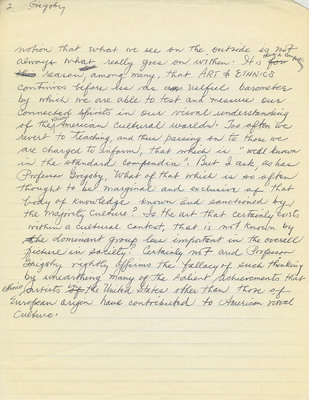Pages
MS01.01.03.B02.F33.001
Long before there was MIXED BLESSINGS, that wonderful book in which Lucy Lippard [crossed out: that] gives an outstanding overview of a multiracial, indeed a mutlticultural overview of art in the United States, there was ART & ETHNICS, a [crossed out: wonderful] pioneering book by the dean of African American art educators, J. Eugene Grigsby, Jr. By providing a sound survey of the visual arts that was all encompassing in both a cultural and historical context, ART & ETHNICS was indeed a "first" to provide tested and proven background information for teaching the basics of visual literacy across racial and ethnic lines in the nation. Shuning total emphasis on the buzz word of the nineties, multiculturalism, Profession Grigsby managed to pull off [crossed out: the] a coup-de-grace in visiting by suggesting succiently that "less is more" when it comes to throwing around those "in" words that fit the talk of the town more than they serve the people who must listen to what is said. And thus, it is true as with those who would seek to affirm our differences along ethnic lines, and not our likenesses, that a careful study of the real meaning of multicultural education must be selectively done, particularly in the visual arts, lest we all end up [crossed out: less] more informed about each other's popular cultural [crossed out: than] acknowledgements rather than that we know to be our true selves.
Several examples of cultural diversion have been cited by the author that lend credence to the
MS01.01.03.B02.F33.002
2 Grigsby
notion that what we see on the outside is not always what really goes on within. It is [crossed out: for] thus a compelling [crossed out: this] reason, among many, that ART & ETHNICS continues before us as a[crossed out: n] useful barometer by which we are able to test and measure our connected spirits in our visual understanding of the various American cultural worlds. Too often we revert to teaching, and thus passing on to those we are charged to inform, that which is "well known in the standard compendia". But I ask, as has Professor Grigsby, What of that which is so often thought to be marginal and exclusive of that body of knowledge known and sanctioned by the majority culture? Is the art that certainly exists within a cultural context, that is not known by the dominant group less important in the overall picture in society? Certainly not and Professor Grigsby rightly affirms the fallacy of such thinking by unearthing many of the salient achievements that ethnic artists [crossed out: of] in the United States other than those of European origin have contributed to American visual culture.



